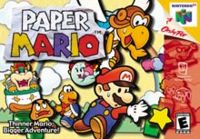Paper Mario

| |
| Paper Mario | |
| Developer | Intelligent Systems |
| Publisher | Nintendo |
| System | Nintendo 64, Virtual Console, Wii U Virtual Console |
| Release Date | Nintendo 64 JP August 11, 2000 US February 4, 2001 EU October 5, 2001 Virtual Console JP July 10, 2007 EU/AU July 13, 2007 US July 16, 2007 Wii U Virtual Console US April 30, 2015 PAL May 21, 2015 JP July 15, 2015 |
| Gallery | GH Gallery |
| Rating | ESRB: E |
Paper Mario (known as Mario Story in Japan) is a Super Mario RPG game that was developed for the Nintendo 64. It was originally conceived as a sequel to Super Mario RPG: Legend of the Seven Stars with the working title of Super Mario RPG 2. Although it takes some inspiration from that game, it ultimately became its own gameplay with its own aesthetic and gameplay variation.
Story
Bowser has stoeln the all-powerful Star Rod from Star Haven and used it to become invincible. With this power, he easily defeats Mario and kidnaps Princess Peach once again. Mario's only hope of taking back the Star Rod and saving the princess is to venture around the Mushroom Kingdom and save the seven Star Spirits. The game is divided into eight chapters and a Prologue, each ending after Mario has saved one of the Star Spirits. Between chapters, the player was given the opportunity to play as Peach and explore her baddie-infested castle, trying to find clues that she could send to Mario.
Gameplay
One notable point of the game is the graphics; Paper Mario holds up to its name by featuring 2-D characters, as if made from pieces of paper, within a colorful 3-D world. In terms of gameplay, this game replaces the standard RPG party system (which Mario RPG had used) with one in which Mario can only fight alongside one partner at a time. Additionally, only Mario has HP, while his partners would instead just be stunned by damage. The game otherwise reprises and expands upon the system of timed hits from Super Mario RPG.
Paper Mario is not a particularly difficult game, with simplified puzzles and battle statistics that never exceed 99 points. The only controllable equipment in the game are badges, which replace the accessories in most RPGs. Unlike most, the number of badges that can be equipped is based on the number of Badge Points Mario currently has.
Legacy
Paper Mario ended up spawning its own Mario subseries that spanned across releases for both consoles and handheld systems.
Sequels
Paper Mario was followed up by Paper Mario: The Thousand-Year Door for the Nintendo Gamecube in 2004. This game in many respects played upon the same formula of the first game. The following game, Super Paper Mario, radically changed the gameplay to reflect Mario's platforming roots, but Paper Mario: Sticker Star has since moved back into the series's original gameplay style.
Rereleases
- At one point it was announced for a rerelease on the Gamecube, but this was quietly canceled, presumably in favor of making Paper Mario: The Thousand-Year Door.
- In 2007, it was released for download over the Wii Virtual Console.
- In 2015, it was released again for download over the Wii U Virtual Console.
See Also